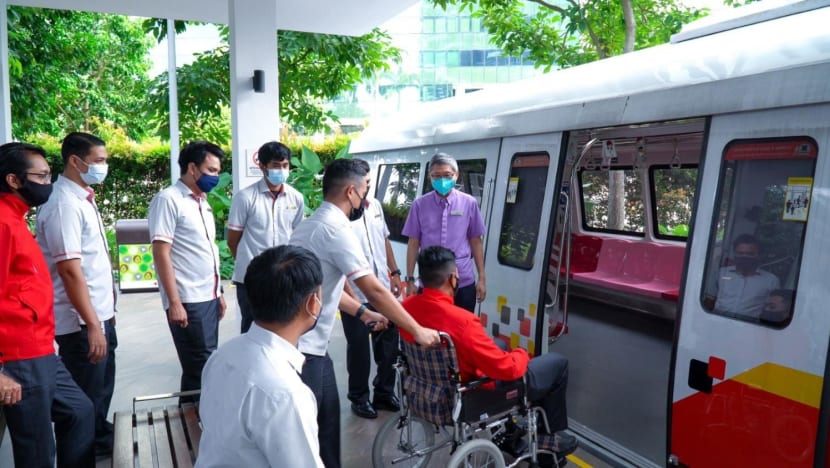SINGAPORE: When new frontline employees be part of transport operator SMRT, many won’t count on to be educated to identify somebody who seems confused, misplaced or anxious.
But it’s obligatory for these staff, together with bus captains and MRT station employees, to attend coaching to establish such passengers and discover ways to reply appropriately.
For occasion, they be taught that they might method a passenger who seems confused by saying: “Afternoon sir, is there anything I can help you with? You seem lost.” And a passenger who seems misplaced and anxious might be advised: “I understand your situation. Allow me to direct you to your destination.”
After all, these passengers may have dementia – and this “inclusivity training” is a part of SMRT’s Demonstrate a Service Vision coaching that features dementia consciousness inside six months of becoming a member of the corporate.
CNA lately attended one such session customised by NTUC LearningHub to swimsuit SMRT’s wants.
Developed in collaboration with the Ministry of Social and Family Development, Jurong Community Hospital, Lien Foundation and Singapore Association of the Visually Handicapped, the course goals to make coaching related and genuine to reinforce transport employees’s understanding of the wants of precedence passengers.
The coaching additionally covers different weak teams, resembling wheelchair customers and the visually impaired. A sensible session is held on the Jurong Community Hospital Mobility Park fitted with steps, slopes and a “mock-up” MRT carriage, bus and taxi, the place therapists from the hospital information SMRT employees on the right way to help precedence passengers.
With about 2 million individuals using the MRT day by day, such coaching is vital for SMRT frontliners, famous Ms Norendrawati Suseno, affiliate coach at NTUC LearningHub.
“Do you know how many people they meet at the MRT a day? So they have more chances than any other industry as a frontliner meeting such passengers. If you can think about the amount of people taking MRT every day, they’re bound to meet one of those that they have learnt about,” she stated.
Ms Norendrawati, who has additionally educated staff from hospitality, points of interest, leisure and retail sectors, identified that the applying of the coaching could be “very different” for transport frontliners.
“It will be very useful because they will be able to actually interact with such passengers. We call them the priority passengers,” she added.
DEMENTIA’S VISIBLE TELL-TALE SIGNS
By the top of this yr, all 98 SMRT prepare stations throughout Singapore on the North-South, East-West, Circle and Thomson-East Coast strains might be listed as dementia “Go-To-Points”, SMRT introduced on Feb 27.
“These GTPs (Go-To-Points) serve as resource centres and ‘safe return’ points where members of the public can bring persons living with dementia who appear lost or unable to remember their way home,” the transport operator stated in a media launch.
“SMRT’s station and interchange staff are trained to identify and assist the persons who have been brought to them, and will assist to reunite them with their caregivers.”
Hence one of many key studying factors of the coaching is figuring out the seen traits of dementia. It additionally particularly addresses situations in crowded and public areas resembling MRT stations or bus interchanges.
At an MRT station, specifically, this might be commuters who look misplaced and confused as they don’t know the place they’re or the place they’re going.
“They may be wandering aimlessly at the MRT platform or not move and just stare blankly at other commuters moving in and out of the train or bus. They may also spend a lot of time staring closely at the signboards or rail information systems,” director of the Institute of Business Excellence at NTUC LearningHub, Anthony Chew, advised CNA.
Other doable situations may embody commuters “shouting, hitting out and even hurling (objects), seemingly unaware of their surroundings”. They may be “unable to communicate themselves when they speak” or “ask a repeat question every few minutes”, added Mr Chew.
For commuters with dementia who “might not disembark at the terminal”, the employees may “approach them tactfully to assist, and not show frustration or force them out of the vehicle”.
Recounting a situation the place a doable particular person with dementia gave the impression to be “spacing out”, Ms Norendrawati stated a restaurant supervisor she as soon as educated had noticed an aged man standing round outdoors his outlet. He thought the person was undecided about coming into the shop, so he knowledgeable the person that he may go in at any time when he was prepared.
“(People with dementia) may actually come to you sometimes, and when you ask them another question, they may suddenly say things like, ‘Where am I? Where is this place?’ And that’s what happened to this particular uncle. That is a sign of dementia,” she stated.
And if the particular person displays such indicators, they shouldn’t be left alone.
“This is where that restaurant manager regretted after sitting in my class, because he said, ‘I don’t know where he went to but I can imagine he probably got lost.’ I told them that if they identify (a possible person with dementia), but they’re not too sure yet, ask them (questions),” she added.
“Sometimes we don’t want to accuse them of having dementia as well. Tell them that you could serve them a drink to make them realise that someone is there, and at the same time, get the connection.”
Some individuals with dementia would possibly throw a mood, so on this state of affairs, “take them aside, reassure them with patience and calmness”, she added.
“Assure them that they’re going to be okay, so they are not embarrassed. Treat them with respect and dignity.”
Additionally, each Mr Chew and Ms Norendrawati advised CNA {that a} widespread false impression addressed within the coaching is that solely the aged undergo from dementia — however it might even occur to youthful people of their 40s, together with those that are “well-educated” and who’re are “often perceived as being more mentally active”.
Mr Chew added that almost all importantly, the course additionally teaches employees to “give much respect to maintain the dignity of persons with dementia”.
“There is a need to ground such individuals and bring them back to reality. It takes a lot of time and patience, as we cannot expect them to immediately remember.”
DEMENTIA AWARENESS TRAINING IS ABOUT LIFE SKILLS
But such inclusivity coaching goes past serving to these dwelling with dementia, as they may not even realise they’ve misplaced their manner, stated Ms Norendrawati.
“Rather, I think it helps the family. It becomes very concerning if you lose your loved one.”
She added that her college students can vary from people who’ve been working for 30 years to a youthful crowd. While the previous might have extra tales to share about their experiences, there’s an occasional youthful employees member with a father or mother who has “gone through certain things that we’ve spoken about or shared”.
“They will say, ‘Yes, my mum is like that. My dad is like that.’ And this is where learning takes place as well. … (The younger SMRT staff) really appreciate (the training), because they get practical tips based on the perspective that others can see, ” she stated.
“(Dementia awareness training) is actually life skills. Because I told them anytime we can have a parent that can come with some of these disabilities.”
In 44-year-old assistant station supervisor Choi Whey Shiong’s expertise, caring for his late grandmother who had dementia made it “quite easy” for him to establish individuals with dementia. He recounted a second previous to attending the coaching the place he noticed an aged male commuter mumbling to himself, and thought “something was not right”.
While Mr Choi managed to assist the commuter with expertise he had, he famous that completely different commuters require completely different “techniques”.
“We cannot have one technique applied to everybody because some are more sensitive. Some might get agitated more easily. So you will need to judge the situation and apply the right method. Of course their safety has to be the priority,” he stated.
Despite his present information about dementia, Mr Choi was given an added increase of confidence after attending the coaching session.
“Without the training, handling persons with dementia was based on self-instinct. Now when I help those commuters in need, I have more confidence. It gives me more courage to do the thing that’s right.”


Source : channelnewsasia.com
The post How do public transport staff identify people with dementia? Behind the scenes with SMRT’s inclusivity training first appeared on Umorr.







